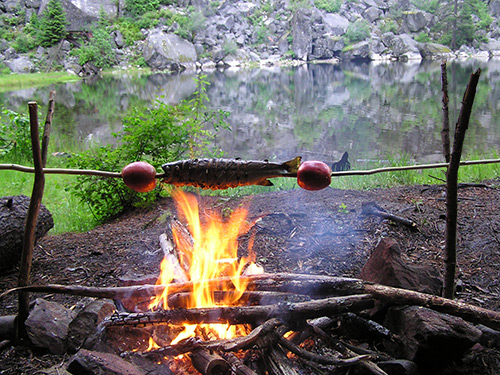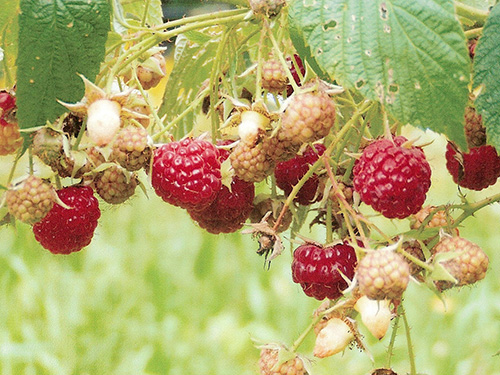Wilderness Survival Food List
So you want to get a survival food list that will help you survive in the wild. At Twin Eagles Wilderness School, we see wilderness survival as a pathway towards not just preserving life, but developing a deep connection with the natural world. The more we know about the foods we can eat in the wild and the greater context within which they exist, the better we are at recognizing wild food when we need to. The better we are at recognizing those foods, the more competent we become at not just enduring survival, but weaving a resilient connection with the Earth.

We've experienced both ends of the spectrum and learned the hard way that a broad survival food list is essential to flourishing in wilderness survival in a wide variety of ecosystems.
For any wild food, you need to take the time to learn to identify the species, and always investigate possible hazards. Does your wild food need to be cooked, or can it be eaten raw? Are there poisonous lookalikes? Are all parts edible, or only some?
The true survivalist takes the time to not just learn, but practice harvesting, preparing, and eating wild foods before an actual time of need. Doing so is a great joy, and a tremendous way to connect with nature, friends, family, and self.
Our hope is that this survival food list can help you deepen your relationship with the natural world, and ultimately live the freedom that comes with knowing what's available to you. With that said, here are our top 133 wild foods for your survival food list.
Meat from animals
It's no wonder many people avidly hunt in the fall when there is the opportunity to get meat from the large animals for the year ahead. A single animal can provide a major source of high quality protein. We've also put the smaller mammals on this survival food list because they are often a much more accessible food supply in a time of need as well.
- White tail deer
- Elk
- Moose
- Caribou
- Wild boar
- Hares & rabbits
- Squirrel
- Chipmunk
- Mice
Meat from Birds
Your survival food list should include inland birds and water fowl. Although feathers can make the amount of meat on a bird seem larger than it really is, birds nonetheless provide an important resource to any survivalist.
- Wild turkey
- Geese
- Swans
- Ducks
- Grouse
- Quail
- Cranes
- Herons
- Pigeons
Insects
From the Paiute to the Peruvians people have been eating insects for thousands of years, long before modern culture. In many cultures, insects are considered a gourmet cuisine. Make sure you remove the wings, antennae and legs from the insects that you gather and anything else you don't want to eat.
- Grasshoppers
- Ants
- Ant larvae
- Crickets
- Maggots
- Aphids
- Termites
- Sowbugs
- Earwigs
- Beetle
- Beetle larvae
Edible Wild Mushrooms
Some of the most well-known of the wild edible mushrooms are the boletes, morels and chanterelles. For more comprehensive information on wild edible mushrooms, including identification, harvesting, preparation, and more, check out our edible wild mushrooms article here.
- Boletes
- Morels
- Chanterelles
- Milk Caps
- Russulas
Reptiles and Amphibians
While alligators and crocodiles can be eaten we suggest three smaller species that are safer to catch.
- Turtles
- Snakes
- Frogs
- Salamanders
Eggs
Bird eggs are high in protein and an excellent food source. Mallard and goose are particularly good species to start with.
- Bird eggs
Ocean Life
There is a lot of life in the ocean that should be on your survival food list. Many are a great source of both protein and fat.
- Fish
- Clams
- Mussels
- Octopus
- Shrimp
- Limpets
- Periwinkles
- Squid
- Urchin
- Oysters
- Lobster
- Crabs
- Sea lettuce
- Kelp
- Nori
- Dulse
Fruit
In the wild there is plenty of fruit in season from early summer through late fall, depending on where you live. While this is not a comprehensive list here are a few to get your survival food list started.
- Wild apple
- Persimmon
- Hawthorn apples
- Cactus
- Agave
- Wild grape
- Wild black cherry
- Mayapple fruits
Berries
Berries are certainly among the easiest of wild foods to gather. One could literally gather them blindfolded. As always, learn the poisonous ones first, as there are far fewer poisonous berries than edible ones. Berries are quick energy foods and packed with lots of nutrition. For a more all-inclusive body of information on wild berries, visit our wild edible berries article here.

- Blackberry
- Raspberry
- Huckleberries
- Salmon berries
- Blueberries
- Cranberries
- Elderberry
- Gooseberry
- Wild strawberry
- Bunchberry
- Mulberry
- Currant & Gooseberries
Flowers
Not many people consider flowers as something to eat. Yet, many flowers contain fiber, vitamins, and important anti-oxidants. Pause before you put together that bouquet or throw them out in the compost for that's good food you could be eating! Many flowers can be eaten just before they open as well as in full bloom. Here's a list of a few flowers to get you started.
- Day lily
- Wild rose
- Trout lily
- Black locust
- Violets
- Honeysuckle
- Passionflower
- Chicory
Greens
There are a plethora of greens growing everywhere in spring, summer and early fall that are edible. In fact, this article could be solely focused on wild plants and we'd go well over 133 very fast. That said, here are some of the most accessible plants for you to forage. For more information on identification, harvesting, and more, take a look at our wild edible plants article here.
- Wild asparagus
- Dandelion
- Nettles
- Plantain
- Violets
- Mints
- Purslane
- Lambs quarters
- Self-heal
- Mallow
- Miner's lettuce
- Fiddle heads
Roots and Shoots
You'll be making huge strides in your food gathering if you gather shoots and even more so roots. Roots are amazing foods stored underground just waiting for you whenever you are hungry. Yes, there are optimal harvest times but generally speaking, as far as survival goes, there are some roots you can gather year round unless the ground freezes. Shoots are an excellent immediate food source and can often be eaten raw.
- Water lily roots
- Burdock root
- Thistle root
- Taro root
- Jerusalem artichoke root
- Cattail roots and shoots
- Watercress shoots
- Bamboo shoots
- Larch and Hemlock shoots/tips
Bulbs, Tubers and Corms
Many bulbs and tubers are like mini potatoes just waiting to be dug up. Typically you'll need to rinse and boil your bulbs, tubers and corms.
- Wood sorrels
- Indian cucumber
- Wild carrot
- Wild onion
- Onion grass
- Wild garlic
- Wild leeks
Nuts
Containing a considerable amount of calories and protein, nuts are great for keeping your energy up over the long haul. Rather than looking to the grocery store shelves, take a lesson from the squirrels and go foraging. We've often found nut trees growing on the edge of forgotten places and been amazed that no one is gathering them. Nuts are great for your survival food list because they can be stored where other foods typically spoil more quickly. Many nuts don't need any processing for storage at all.
- Acacia
- Hickory
- Walnut
- Hazelnut
- Acorn
- Chinquapin
- Beech nuts
- Chestnut
- Pecan
- Butternut
- Pinon nuts
- Macadamia
Grasses, Grains, Seeds, and Pods
A great way to add more nutrients to your survival food list. Many grasses can be chewed raw for their nutritious juices, then spit out as the fibers can be difficult to digest.
- Wild rice
- Gammagrass
- Wild barnyard grass
- Indian rice grass
- Sunflower seeds
- Wild rye
- Dock seeds
- Chia seeds
- Mesquite pods
- Milkweed pods
Ethics
When harvesting, hunting, and gathering be mindful of ethics. Our earth based ancestors long ago lived well and continued to live amongst a flourishing landscape because they only took what they needed and no more. Being honorable, sensitive, appreciative, and aware of the plants, animals, birds and all that lives and breathes through the landscape every day is an essential part of that perspective as well.
Consider a symbiotic relationship with that plant before you take life to sustain your own. We recommend being conservative with your harvesting, hunting, and gathering until you are completely confident of the process.
In the process of compiling and expanding your survival food list through direct experience, you'll find that you will deepen your knowledge of the land and discover and unravel the web of ecological predator prey relationships surrounding you. Through this direct experience you'll discover that you too are an essential part of the web of life. It can often feel quite humbling and eye opening to discover just how much food it takes for us to survive.
A Deeper Connection
While survival can be a lot of effort, it can also be an incredibly thrilling, connective, and deeply meaningful experience. There is a depth of connection and meaning that the survival TV shows don't even begin to hint at.
The journey of learning to eat wild foods is a highly personal and intimate experience of discovering an ancient relationship deeply woven into the very essence of what it means to be human. Each new food we learn and eat becomes a cherished relationship that can last a lifetime and beyond.
When we look to indigenous traditions, a common approach is to treat the wild foods as people. It is an older world view, one of deep respect and recognition of the highly interrelated web of life. While that may be challenging to accept for modern people, imagine what our relationship with the Earth would be like if we brought that kind of respect each time we interacted with the natural world.
Here at Twin Eagles Wilderness School, we envision a world where that deep level of respect and connection with the web of life once again prospers, causing all the wild foods and the human family to flourish. Thanks for joining us.
Interested in being personally mentored in Wilderness Survival & Edible Wild Plants, on a transformational journey of connection to nature, community, and self?
Check out the Twin Eagles Wilderness Immersion Program.
comments powered by Disqus
Return from Survival Food List to Wilderness Survival Guide
Return from Survival Food List to Wilderness Survival (homepage)
Track Us